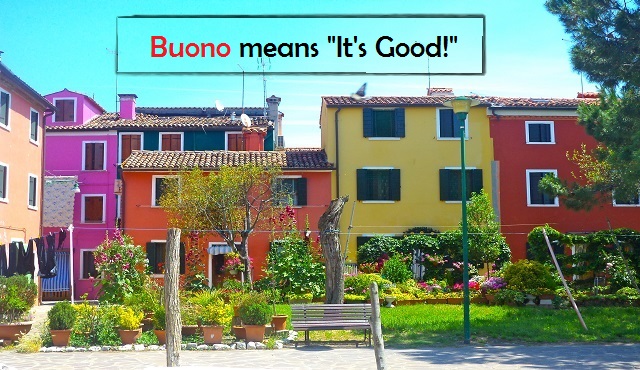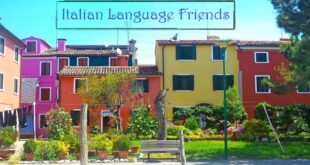 Buono is an adjective that will come up quite often when one starts to learn Italian, and it’s one that you’ll use often while traveling — so many things are good in Italy! But, the form of this adjective will change according to the masculine or feminine form of the noun (person, place or thing) it modifies, the number of “things” that are good, and also according to where this adjective is placed in the sentence.
Buono is an adjective that will come up quite often when one starts to learn Italian, and it’s one that you’ll use often while traveling — so many things are good in Italy! But, the form of this adjective will change according to the masculine or feminine form of the noun (person, place or thing) it modifies, the number of “things” that are good, and also according to where this adjective is placed in the sentence.
Sound complicated? Well, it is… a little bit. But luckily, there are many “commonly used phrases” spoken every day in Italy that use the word buono. These are “meeting and greeting phrases” that come up when one says things like “hello,” “good day” or “good evening” and are phrases we will certainly use every day with family and friends, as well as with acquaintances in Italy.
And, by remembering these common Italian phrases, you will automatically have committed the rules for how to use the adjective buono to memory!
How to Use Buono
with Singular Nouns
We will start by explaining how to use buono with singular masculine nouns.
For masculine nouns, buono is placed either directly after the noun, or at the end of a sentence that uses the Italian verb è for is. In the second case, the adjective buono will be separated from the noun it modifies, but both the noun and adjective will agree in gender and number.
So, in our example below, we see that there are two ways to express the idea that you are having a good day. In both cases, the adjective buono is placed after the singular masculine noun giorno.
| Il giorno è buono. | The day is good. |
| il giorno buono | the good day |
When the adjective buono is placed before a masculine noun, however, the last letter -o is dropped from buono to make buon, as in, “Buon giorno!”
| Buon giorno! | Good day! |
| buon uomo | good man |
| buon bambino buon ragazzo |
good baby (boy) good boy |
The masculine buon is also an important word to remember when one wants to express good wishes to another, such as with the phrase, “Happy Birthday!” In Italian, these phrases can start with, ” Auguri di…” meaning, “Best wishes for…” But, more often than not, Italians use shorter phrases to wish others well, and these phrases often start with “Buon…”
Check out the table below for some common phrases of best wishes.
Buon divertimento! I hope you have a good time!
| Auguri di buon compleanno! | Best wishes for a happy birthday! |
| Buon compleanno! | Happy birthday! |
| Buon anniversario! | Happy anniversary! |
| Buon viaggio! | Have a good trip! |
| Buon divertimento! | Have fun! Have a good time! |
| Buon Natale! | Merry Christmas! |
| Buon anno! | Happy New Year! |
| Felice anno nuovo! | Happy New Year! (less commonly used) |
Now let’s talk about how to use buono with singular feminine nouns.
For a feminine noun, the adjective buona is used to describe something good, whether placed before or after the noun this adjective modifies. Again, one of our “meeting and greeting” phrases, “Buona sera,” will help us to remember this rule.*
Also, if you want to express the wish that someone has a good day for the entire day, you can use the adjective buona with the phrase “Buona giornata!” The same applies for the entire evening with the phrase “Buona serata!”
Check out the table below for some common phrases that use buona.
Buona fortuna! Good luck!
| La frutta è buona oggi. la buona frutta |
The fruit is good today. the good fruit |
| Buona sera! | Good evening! |
| Buona giornata! | Have a good day! (wish for the entire day to be good) |
| Buona serata! | Have a good evening! (wish for the entire evening to be good) |
| Buona idea! | Good idea! |
| Buona fortuna! | Good luck! |
There is only one exception to the rule above: if buona is placed before a feminine noun that begins with the letter –a, simply drop the last letter from buona and add an apostrophe to make buon’ for smoother conversation. Since our focus is on conversational Italian, just remember to bring the two words together when speaking, without repeating the -a ending, and don’t worry for now about the spelling!
So, if you want tell someone your friend—who is a girl—is a “good friend” to you, you could say, “la buon’amica mia,” for “my good friend.”
*Some of these phrases can also be written as one word, as in: buongiorno, buonasera, and buonanotte.
How to Use Buono
with Plural Nouns
The adjective buono follows the usual Italian rules for changing singular adjectives to plural adjectives.
In general, of course:
- A masculine Italian noun and its adjective will end in -o, and this ending will change to -i in the plural.
- A feminine Italian noun and its adjective will ends in -a, and this ending will change to -e in the plural.
- An Italian noun or adjective that ends in -e may be masculine or feminine, and this ending will change to -i in the plural.
If you are interested in learning more about masculine and feminine words in Italian that end in the letter -e, and how to distinguish one from the other, this You Tube Video may be of help: Italian Grammar by Stella Lucente, LLC.
For our adjective buono, the following rules apply:
- For the masculine forms of the adjective buono, the plural is always buoni.
- For the feminine forms of the adjective buona, the plural is always buone.
With these simple rules, we are ready to create some common noun/adjective combinations using buono and buona!
| il giorno buono | the good day | becomes the good days |
i giorni buoni |
| il buon giorno | the good day | becomes the good days |
i buoni giorni |
| la buona notizia | the good news (one piece of news) |
becomes the good news |
le buone notizie |
There are, of course, many more occasions to use the Italian adjective buono than those I have just listed. How many more an you think of?
Remember common Italian expressions with the adjective buono
and I guarantee you will use then every day!
If you’d like to read the earlier posts in the series, “Italian Phrases We Use EVERY Day!” just click HERE.
 Fra Noi Embrace Your Inner Italian
Fra Noi Embrace Your Inner Italian






2 comments
Pingback: Adding color with adjectives – Fra Noi
Pingback: Familiar Italian Commands – Fra Noi